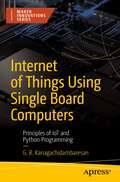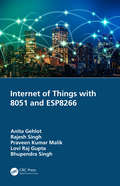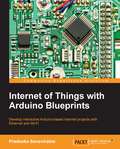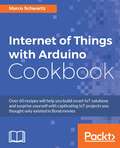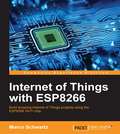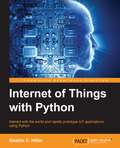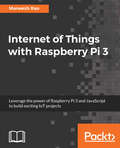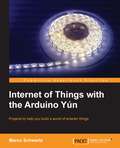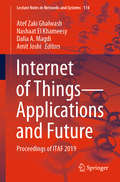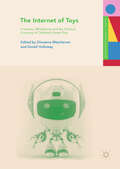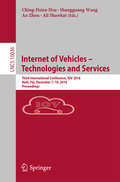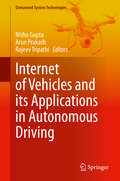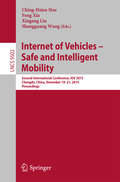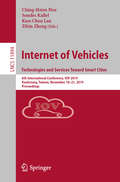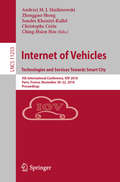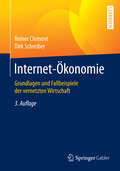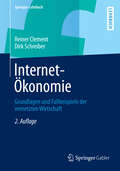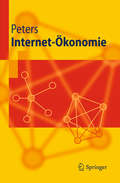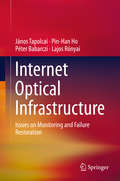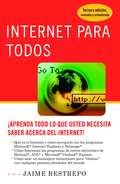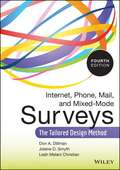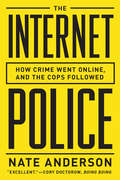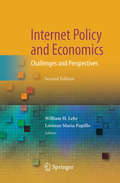- Table View
- List View
Internet of Things Using Single Board Computers: Principles of IoT and Python Programming (Maker Innovations Ser.)
by G. R. KanagachidambaresanRapidly prototype and program new IoT and Edge solutions using low-cost Maker tech, such as those from Arduino, Raspberry Pi and Nvidia. With a focus on the electronics, this book allows experienced computer science students as well as researchers, practitioners, and even hobbyists to dive right into actual engineering of prototypes and not just theoretical programming and algorithms. You'll learn to interface sensors, work with various communication mediums, incorporate wired and wireless communication protocols, and more with these single board computers. All while working in the popular Python programming language. Additionally, you’ll discover both scripting-based and drag and drop solutions for different problems. As well as a variety of useful, data gathering approaches. Then you can apply what you’ve learned to IoT projects and troubleshooting Industry 4.0 problems. The rapid growth of technology and new development initiatives has made the Internet of Things and Edge analytics an inevitable platform in all engineering domains. The need for sophisticated and ambient environments controlled by tech has resulted in an exponential growth of automation and artificial intelligence. Internet of Things Using Single Board Computers reflects these recent developments while providing a low-cost, easy ramp into the fields of IoT using single board computers and Python programming. What You'll LearnProgram Arduino, Raspberry Pi, and Nvidia boards for rapid prototyping in IoT and Edge environmentsInterface sensors, communication mediums, and wired and wireless communications into your programs and projects.Study practical applications of these low-cost solutions in fields such as home automation, smart cities, electrical vehicle charging, and more.Who This Book is ForEngineers and hobbyists working on Internet of Things prototypes and applications. Basic skills in electronics and a working knowledge of Python are recommended. Engineers and scientists working on smart environment projects and smart city applications will also benefit.
Internet of Things with 8051 and ESP8266
by Anita Gehlot Rajesh Singh Praveen Kumar Malik Lovi Raj Gupta Bhupendra SinghInternet of Things with 8051 and ESP8266 provides a platform to get started with the Internet of Things (IoT) with 8051. This book describes programming basics and how devices interface within designed systems. It presents a unique combination of 8051 with ESP8266 and I/O devices for IoT applications supported by case studies to provide the solutions to real-time problems. The programs and circuits have been tested on real hardware and explore different areas in IoT applications. Divided into four sections, it explains the customized boards for IoT applications followed by the means by which 8051 and ESP8266 interface with I/O devices. It spans levels from basic to advanced interfacing with special devices, server design, and data logging with different platforms. Features: Covers how I/O devices interface with 8051 and ESP8266 Explains the basic concepts of interfacing complexity using applications with examples Provides hands-on practice exercises with 8051 and ESP8266 for IoT applications Discusses both case studies and programming tests on real hardware during industrial and student projects Reviews the integration of smart devices with IoT Internet of Things with 8051 and ESP8266 is intended for senior undergraduate and graduate students in electrical and electronics engineering, but anyone with an interest in the professional curriculum of electrical and electronics engineering will find this book a welcome addition to their collection.
Internet of Things with Arduino Blueprints
by Pradeeka SeneviratneDevelop interactive Arduino-based Internet projects with Ethernet and WiFiAbout This BookBuild Internet-based Arduino devices to make your home feel more secureLearn how to connect various sensors and actuators to the Arduino and access data from InternetA project-based guide filled with schematics and wiring diagrams to help you build projects incrementallyWho This Book Is ForThis book is intended for those who want to learn more about Arduino and make Internet-based interactive projects with Arduino. If you are an experienced software developer who understands the basics of electronics, then you can quickly learn how to build the Arduino projects explained in this book.What You Will LearnMake a powerful Internet controlled relay with an embedded web server to monitor and control your home electrical appliancesBuild a portable Wi-Fi signal strength sensor to give haptic feedback about signal strength to the userMeasure water flow speed and volume with liquid flow sensors and record real-time readingsSecure your home with motion-activated Arduino security cameras and upload images to the cloudImplement real-time data logging of a solar panel voltage with Arduino cloud connectorsTrack locations with GPS and upload location data to the cloudControl a garage door light with your Twitter feedControl infrared enabled devices with IR remote and ArduinoIn DetailArduino is a small single-chip computer board that can be used for a wide variety of creative hardware projects. The hardware consists of a simple microcontroller, board, and chipset. It comes with a Java-based IDE to allow creators to program the board. Arduino is the ideal open hardware platform for experimenting with the world of the Internet of Things. This credit card sized Arduino board can be used via the Internet to make more useful and interactive Internet of things projects.Internet of Things with Arduino Blueprints is a project-based book that begins with projects based on IoT and cloud computing concepts. This book covers up to eight projects that will allow devices to communicate with each other, access information over the Internet, store and retrieve data, and interact with users--creating smart, pervasive, and always-connected environments. It explains how wired and wireless Internet connections can be used with projects and the use of various sensors and actuators. The main aim of this book is to teach you how Arduino can be used for Internet-related projects so that users are able to control actuators, gather data from various kinds of sensors, and send and receive data wirelessly across HTTP and TCP protocols.Finally, you can use these projects as blueprints for many other IoT projects and put them to good use. By the end of the book, you will be an expert in the use of IoT with Arduino to develop a set of projects that can relate very well to IoT applications in the real world.Style and approachEvery chapter in this book clearly explains how to assemble components through easy-to-follow steps on while laying out important concepts, code snippets, and expected output results so that you can easily end up with a successful project where you can also enhance or modify the project according to your requirements.
Internet of Things with Arduino Cookbook
by Marco SchwartzThis book is primarily for tech enthusiasts and early IoT adopters who would like to make the most of IoT and address the challenges encountered while developing IoT-based applications with Arduino. This book is also good for developers with basic electronics knowledge who need help to successfully build Arduino projects.
Internet of Things with ESP8266
by Marco SchwartzBuild amazing Internet of Things projects using the ESP8266 Wi-Fi chip About This Book * Get to know the powerful and low cost ESP8266 and build interesting projects in the field of Internet of Things * Configure your ESP8266 to the cloud and explore the networkable modules that will be utilized in the IoT projects * This step-by-step guide teaches you the basics of IoT with ESP8266 and makes your life easier Who This Book Is For This book is for those who want to build powerful and inexpensive IoT projects using the ESP8266 WiFi chip, including those who are new to IoT, or those who already have experience with other platforms such as Arduino. What You Will Learn * Control various devices from the cloud * Interact with web services, such as Twitter or Facebook * Make two ESP8266 boards communicate with each other via the cloud * Send notifications to users of the ESP8266, via email, text message, or push notifications * Build a physical device that indicates the current price of Bitcoin * Build a simple home automation system that can be controlled from the cloud * Create your own cloud platform to control ESP8266 devices In Detail The Internet of Things (IoT) is the network of objects such as physical things embedded with electronics, software, sensors, and connectivity, enabling data exchange. ESP8266 is a low cost WiFi microcontroller chip that has the ability to empower IoT and helps the exchange of information among various connected objects. ESP8266 consists of networkable microcontroller modules, and with this low cost chip, IoT is booming. This book will help deepen your knowledge of the ESP8266 WiFi chip platform and get you building exciting projects. Kick-starting with an introduction to the ESP8266 chip, we will demonstrate how to build a simple LED using the ESP8266. You will then learn how to read, send, and monitor data from the cloud. Next, you'll see how to control your devices remotely from anywhere in the world. Furthermore, you'll get to know how to use the ESP8266 to interact with web services such as Twitter and Facebook. In order to make several ESP8266s interact and exchange data without the need for human intervention, you will be introduced to the concept of machine-to-machine communication. The latter part of the book focuses more on projects, including a door lock controlled from the cloud, building a physical Bitcoin ticker, and doing wireless gardening. You'll learn how to build a cloud-based ESP8266 home automation system and a cloud-controlled ESP8266 robot. Finally, you'll discover how to build your own cloud platform to control ESP8266 devices. With this book, you will be able to create and program Internet of Things projects using the ESP8266 WiFi chip. Style and approach This is a step-by-step guide that provides great IOT projects with ESP8266. All the key concepts are explained details with the help of examples and demonstrations of the projects.
Internet of Things with Python
by Gaston C. HillarInteract with the world and rapidly prototype IoT applications using Python About This Book * Rapidly prototype even complex IoT applications with Python and put them to practical use * Enhance your IoT skills with the most up-to-date applicability in the field of wearable tech, smart environments, and home automation * Interact with hardware, sensors, and actuators and control your DIY IoT projects through Python Who This Book Is For The book is ideal for Python developers who want to explore the tools in the Python ecosystem in order to build their own IoT applications and work on IoT-related projects. It is also a very useful resource for developers with experience in other programming languages that want to easily prototype IoT applications with the Intel Galileo Gen 2 board. What You Will Learn * Prototype and develop IoT solutions from scratch with Python as the programming language * Develop IoT projects with Intel Galileo Gen 2 board along with Python * Work with the different components included in the boards using Python and the MRAA library * Interact with sensors, actuators, and shields * Work with UART and local storage * Interact with any electronic device that supports the I2C bus * Allow mobile devices to interact with the board * Work with real-time IoT and cloud services * Understand Big Data and IoT analytics In Detail Internet of Things (IoT) is revolutionizing the way devices/things interact with each other. And when you have IoT with Python on your side, you'll be able to build interactive objects and design them. This book lets you stay at the forefront of cutting-edge research on IoT. We'll open up the possibilities using tools that enable you to interact with the world, such as Intel Galileo Gen 2, sensors, and other hardware. You will learn how to read, write, and convert digital values to generate analog output by programming Pulse Width Modulation (PWM) in Python. You will get familiar with the complex communication system included in the board, so you can interact with any shield, actuator, or sensor. Later on, you will not only see how to work with data received from the sensors, but also perform actions by sending them to a specific shield. You'll be able to connect your IoT device to the entire world, by integrating WiFi, Bluetooth, and Internet settings. With everything ready, you will see how to work in real time on your IoT device using the MQTT protocol in python. By the end of the book, you will be able to develop IoT prototypes with Python, libraries, and tools. Style and approach This book takes a tutorial-like approach with mission critical chapters. The initial chapters are introductions that set the premise for useful examples covered in later chapters.
Internet of Things with Raspberry Pi 3: Leverage the power of Raspberry Pi 3 and JavaScript to build exciting IoT projects
by Maneesh RaoUnleash the power of the Raspberry Pi 3 board to create interesting IoT projectsKey FeaturesLearn how to interface various sensors and actuators with the Raspberry Pi 3 and send this data to the cloud.Explore the possibilities offered by the IoT by using the Raspberry Pi to upload measurements to Google Docs.A practical guide that will help you create a Raspberry Pi robot using IoT modules.Book DescriptionThis book is designed to introduce you to IoT and Raspberry Pi 3. It will help you create interesting projects, such as setting up a weather station and measuring temperature and humidity using sensors; it will also show you how to send sensor data to cloud for visualization in real-time. Then we shift our focus to leveraging IoT for accomplishing complex tasks, such as facial recognition using the Raspberry Pi camera module, AWS Rekognition, and the AWS S3 service. Furthermore, you will master security aspects by building a security surveillance system to protect your premises from intruders using Raspberry Pi, a camera, motion sensors, and AWS Cloud. We'll also create a real-world project by building a Wi-Fi – controlled robot car with Raspberry Pi using a motor driver circuit, DC motor, and a web application.This book is a must-have as it provides a practical overview of IoT’s existing architectures, communication protocols, and security threats at the software and hardware levels—security being the most important aspect of IoT.What you will learnUnderstand the concept of IoT and get familiar with the features of Raspberry Pi Learn to integrate sensors and actuators with the Raspberry PiCommunicate with cloud and Raspberry using communication protocols such as HTTP and MQTT Build DIY projects using Raspberry Pi, JavaScript/node.js and cloud (AWS) Explore the best practices to ensure the security of your connected devicesWho this book is forIf you're a developer or electronics engineer and are curious about the Internet of Things, then this is the book for you. With only a rudimentary understanding of electronics, the Raspberry Pi, or similar credit-card sized computers, and some programming experience, you will be taught to develop state-of-the-art solutions for the Internet of Things in an instant.
Internet of Things with the Arduino Yún
by Marco SchwartzAll projects are explained in a step-by-step manner, always starting with the assembly of the hardware and followed by basic tests of every hardware component. You will then learn how to build exciting applications in a practical manner based on the details of the projects. This book is intended for people who already have some experience with the Arduino platform and who want to build more exciting applications, in particular to Internet of Things. You will need to have some basic experience in electronics, Arduino, and programming in general to follow the projects created in the book.
Internet of Things—Applications and Future: Proceedings of ITAF 2019 (Lecture Notes in Networks and Systems #114)
by Amit Joshi Atef Zaki Ghalwash Nashaat El Khameesy Dalia A. MagdiThis book is a collection of the best research papers presented at the First World Conference on Internet of Things: Applications & Future (ITAF 2019), Sponsored by GR Foundation and French University in Egypt, held at Triumph Luxury Hotel, Cairo, Egypt, on 14–15 October 2019. It includes innovative works from leading researchers, innovators, business executives, and industry professionals that cover the latest advances in and applications for commercial and industrial end users across sectors within the emerging Internet of Things ecosphere. It addresses both current and emerging topics related to the Internet of Things such as big data research, new services and analytics, Internet of Things (IoT) fundamentals, electronic computation and analysis, big data for multi-discipline services, security, privacy and trust, IoT technologies, and open and cloud technologies.
The Internet of Toys: Practices, Affordances and the Political Economy of Children’s Smart Play (Studies in Childhood and Youth)
by Giovanna Mascheroni Donell HollowayThe Internet of Toys (IoToys) is a developing market within our Internet of Things (IoT) ecosystem. This book examines the rise of internet-connected toys and aims to anticipate the opportunities and risks of IoToys before their widespread diffusion. Contributors to this volume each provide a critical analysis of the design, production, regulation, representation and consumption of internet-connected toys. In order to address the theoretical, methodological and policy questions that arise from the study of these new playthings, and contextualise the diverse opportunities and challenges that IoToys pose to educators, families and children themselves, the chapters engage with notions of mediatization, datafication, robotification, connected and post-digital play. This timely engagement with a key transformation in children’s play will appeal to all readers interested in understanding the social uses and consequences of IoToys, and primarily to researchers and students in children and media, early childhood studies, media and communications, sociology, education, social psychology, law and design.
Internet of Vehicles – Technologies and Services
by Ching-Hsien Hsu Shangguang Wang Ao Zhou Ali ShawkatThis book constitutes the refereed proceedings of the Third International Conference on Internet of Vehicles, IOV 2016, held in Nadi, Fiji, in December 2016. The 22 full papers presented were carefully reviewed and selected from 55 submissions. IOV 2016 is intended to play an important role for researchers and industry practitioners to exchange information regarding advancements in the state of art and practice of IOV architectures, protocols, services, and applications, as well as to identify emerging research topics and define the future directions of IOV.
Internet of Vehicles and its Applications in Autonomous Driving (Unmanned System Technologies)
by Nishu Gupta Arun Prakash Rajeev TripathiThis book provides an insight on the importance that Internet of Vehicles (IoV) solutions can have in taking care of vehicular safety through internetworking and automation. Key features of the book are the inclusion and elaboration of recent and emerging developments in various specializations of intelligent transportation systems and their solutions by incorporating IoT (Internet of Things) and IoV. This book presents to its readers useful IoV applications and architectures that cater to their improved driving requirements and lead towards autonomous driving. The application domains have a large range in which vehicular networking, communication technology, sensor devices, computing materials and devices, IoT communication, vehicular and on-road safety, data security and other topics are included.
Internet of Vehicles - Safe and Intelligent Mobility
by Ching-Hsien Hsu Feng Xia Xingang Liu Shangguang WangThis book constitutes the refereed proceedings of the Second International Conference on Internet of Vehicles, IOV 2015, held in Chengdu, China, in December 2015. The 40 full papers presented were carefully reviewed and selected from 128 submissions. They focus on the following topics: IOV architectures and applications; intelligent mobility; V2V and M2M communications; and modeling and simulations.
Internet of Vehicles. Technologies and Services Toward Smart Cities: 6th International Conference, IOV 2019, Kaohsiung, Taiwan, November 18–21, 2019, Proceedings (Lecture Notes in Computer Science #11894)
by Zibin Zheng Ching-Hsien Hsu Sondès Kallel Kun-Chan LanThis book constitutes the proceedings of the 6th International Conference on the Internet of Vehicles, IOV 2019, which took place in Kaohsiung, Taiwan, in November 2019. The 23 papers presented in this volume were carefully reviewed and selected from 101 submissions. The papers focus on providing new efficient solutions with digital intervehicular data transfer and overall communications. Yet, IOV is different from Telematics, Vehicle Ad hoc Networks, and Intelligent Transportation, in which vehicles like phones can run within the whole network, and obtain various services by swarm intelligent computing with people, vehicles, and environments.
Internet of Vehicles. Technologies and Services Towards Smart City: 5th International Conference, IOV 2018, Paris, France, November 20–22, 2018, Proceedings (Lecture Notes in Computer Science #11253)
by Andrzej M.J. Skulimowski Zhengguo Sheng Sondès Khemiri-Kallel Christophe Cérin Ching-Hsien HsuThis book constitutes the proceedings of the 5th International Conference on the Internet of Vehicles, IOV 2018, which took place in Paris, France, in November 2018. This year’s theme was “Technologies and Services Towards Smart City”. The 21 papers presented in this volume were carefully reviewed and selected from 41 submissions. The papers are organized in topical sections named: IoV communications and networking; IoV clouds and services; vehicular modeling and simulation; and vehicular security and privacy.
Internet-Ökonomie
by Reiner Clement Dirk SchreiberSeit Beginn der 1990er Jahre haben Informations- und Kommunikationstechnologien sowie das Internet einen tief greifenden Wandel hin zur Wissensgesellschaft ausgelöst. Wissen ist der einzige Produktionsfaktor, der sich durch Gebrauch vermehrt. Mit dem Web 2.0 werden innovative Formen der Interaktion zwischen Nutzern möglich. Aus diesem Wandel entstehen neue Fragestellungen: * Welche Regeln prägen die Internet-Ökonomie und worin unterscheiden sich diese von realen Märkten? * Wie lässt sich das für ökonomische Transaktionen wichtige Vertrauen schaffen? * Sind elektronische Märkte transparenter und werden Kunden mündiger? * Wie generieren Unternehmen auf elektronischen Märkten Wertschöpfung? * Werden elektronische Märkte von wenigen Unternehmen beherrscht? Das Buch führt den Leser in die Grundlagen der Internet-Ökonomie ein und erläutert anhand von praxisnahen Fallbeispielen und Übungsaufgaben ihre Funktionsweise. Lösungs- und Bearbeitungshinweise finden sich im Web.
Internet-Ökonomie: Grundlagen und Fallbeispiele der vernetzten Wirtschaft (Springer-Lehrbuch)
by Reiner Clement Dirk SchreiberInnovative Informations- und Kommunikationstechniken bzw. -technologien, das Internet und der Mobilfunk sind inzwischen fester und unverrückbarer Bestandteil unseres Alltags. Der noch vor Jahrzehnten beschriebene Strukturwandel zur Wissensgesellschaft ist Wirklichkeit. Das Web 2.0 verändert die Grundformen der ökonomischen Leistungserstellung und macht neue Arten der Interaktion zwischen Unternehmen und Kunden sowie der Nutzer untereinander möglich. Das Buch untersucht die Prinzipien der Internet-Ökonomie und die Auswirkungen des Internets für Grundformen der ökonomischen Leistungserstellung. Dazu zählen das Kaufen und Verkaufen auf elektronischen Märkten, das Tauschen, Teilen und die soziale Interaktion in sozialen Netzwerken. Das Buch entwickelt dazu einen systematischen und übergreifenden Ansatz. Eine Vielzahl von Fallbeispielen und Übungsaufgaben bieten einen hohen Anwendungsbezug. Die Lösungshinweise zu den Fallbeispielen und Übungsaufgaben sowie rund 300 Abb. sind als Download unter http://www.springer.com verfügbar.
Internet-Ökonomie
by Ralf PetersDas Internet als Eckpfeiler der modernen Informationsgesellschaft hat sowohl neue, digitale Märkte geschaffen als auch bestehende Märkte grundlegend verändert. Der Autor stellt die besonderen Merkmale der Internet-Ökonomie systematisch dar. Dazu wendet er klassische ökonomische Modelle auf das Internet an, stellt aber auch neue Modelle vor. Die Gesetzmäßigkeiten der Internet-Ökonomie werden anhand vieler Beispiele aufgedeckt, daraus der Erfolg etablierter Anbieter erklärt und Handlungsempfehlungen für Akteure der Internet-Ökonomie abgeleitet.
Internet-Ökonomie: Grundlagen und Fallbeispiele der vernetzten Wirtschaft
by Dirk Schreiber Reiner ClementInnovative Informations- und Kommunikationstechniken bzw. -technologien, das Internet und der Mobilfunk sind inzwischen fester und unverrückbarer Bestandteil unseres Alltags. Der noch vor Jahrzehnten beschriebene Strukturwandel zur Wissensgesellschaft ist Wirklichkeit. Das Web 2.0 verändert die Grundformen der ökonomischen Leistungserstellung und macht neue Arten der Interaktion zwischen Unternehmen und Kunden sowie der Nutzer untereinander möglich. Das Buch untersucht die Prinzipien der Internet-Ökonomie und die Auswirkungen des Internets für Grundformen der ökonomischen Leistungserstellung. Dazu zählen das Kaufen und Verkaufen auf elektronischen Märkten, das Tauschen, Teilen und die soziale Interaktion in sozialen Netzwerken. Das Buch entwickelt dazu einen systematischen und übergreifenden Ansatz. Eine Vielzahl von Fallbeispielen und Übungsaufgaben bieten einen hohen Anwendungsbezug. Die Lösungshinweise zu den Fallbeispielen und Übungsaufgaben sowie rund 300 Abb. sind als Download unter http://www.springer.com verfügbar.
Internet Optical Infrastructure
by János Tapolcai Pin-Han Ho Péter Babarczi Lajos RónyaiThis book covers the issues of monitoring, failure localization, and restoration in the Internet optical backbone, and focuses on the progress of state-of-the-art in both industry standard and academic research. The authors summarize, categorize, and analyze the developed technology in the context of Internet fault management and failure recovery under the Generalized Multi-Protocol Label Switching (GMPLS), via both aspects of network operations and theories.
Internet para todos: Aprenda Todo Lo Que Usted Necesita Saber Acerca Del Internet!
by Jaime Restrepo¡Aprenda todo lo que usted necesita saber acerca del Internet!Cómo utilizar los navegadores más populares: Internet Explorer, Safari, NetscapeCómo funciona el correo electrónico, incluyendo los programas MS Outlook® y Hotmail Cómo usar el mensajero instantáneo, inclusive para hacer llamadas por el Internet
Internet para todos
by Jaime A. Restrepo"Con Internet para todos, dar el primer paso para adentrarse en el mundo de las computadoras no es mas difícil que aprender a montar en bicicleta. Una vez que usted pierda el temor inicial a usarlo, el maravilloso universo del Internet estará a su alcance. " --Enrique Gonzales, Director, Hispanic Online (www. hisp. com) Usando este libro aprenderá todo lo necesario para usar el Internet: Cómo usar los navegadores Cómo usar el correo electrónico Cómo crear una página personal o "home page" Cómo bajar programas del Internet a su disco duro Con ilustraciones detalladas, un glosario de terminología de computadoras, y una lista de lugares del Web para hispanoparlantes, este as el úníco libro que usted necesitará. Deje que, con ilustraciones pormenorizadas, sea su guía mientras explora esta maravillosa tecnología llamada el Internet.
Internet, Phone, Mail, and Mixed-Mode Surveys: The Tailored Design Method (Fourth Edition)
by Don A. Dillman Leah Melani Christian Jolene D. SmythThe classic survey design reference, updated for the digital age For over two decades, Dillman's classic text on survey design has aided both students and professionals in effectively planning and conducting mail, telephone, and, more recently, Internet surveys. The new edition is thoroughly updated and revised, and covers all aspects of survey research. It features expanded coverage of mobile phones, tablets, and the use of do-it-yourself surveys, and Dillman's unique Tailored Design Method is also thoroughly explained. This invaluable resource is crucial for any researcher seeking to increase response rates and obtain high-quality feedback from survey questions. Consistent with current emphasis on the visual and aural, the new edition is complemented by copious examples within the text and accompanying website. This heavily revised Fourth Edition includes: Strategies and tactics for determining the needs of a given survey, how to design it, and how to effectively administer it How and when to use mail, telephone, and Internet surveys to maximum advantage Proven techniques to increase response rates Guidance on how to obtain high-quality feedback from mail,electronic, and other self-administered surveys Direction on how to construct effective questionnaires,including considerations of layout The effects of sponsorship on the response rates of surveys Use of capabilities provided by newly mass-used media:interactivity, presentation of aural and visual stimuli. The Fourth Edition reintroduces the telephone-including coordinating land and mobile. Grounded in the best research, the book offers practical how-to guidelines and detailed examples for practitioners and students alike.
The Internet Police: How Crime Went Online, and the Cops Followed
by Nate AndersonChaos and order clash in this riveting exploration of crime and punishment on the Internet. With a new afterword that brings the book's stories up to date, including law enforcement's dramatic seizure of the online black market Silk Road. Once considered a borderless and chaotic virtual landscape, the Internet is now home to the forces of international law and order. It's not just computer hackers and cyber crooks who lurk in the dark corners of the Web--the cops are there, too. In The Internet Police, Ars Technica editor Nate Anderson takes readers on a behind-the-screens tour of landmark cybercrime cases, revealing how criminals continue to find digital and legal loopholes even as police hurry to cinch them closed. From the Cleveland man whose "natural male enhancement" pill inadvertently protected the privacy of your e-mail to the Russian spam king who ended up in a Milwaukee jail to the Australian arrest that ultimately led to the breakup of the largest child pornography ring in the United States, Anderson draws on interviews, court documents, and law-enforcement reports to reconstruct accounts of how online policing actually works. Questions of online crime are as complex and interconnected as the Internet itself. With each episode in The Internet Police, Anderson shows the dark side of online spaces--but also how dystopian a fully "ordered" alternative would be.
Internet Policy and Economics
by William H. Lehr Lorenzo Maria PupilloFor over a decade, William Lehr, Lorenzo Pupillo, and their colleagues in academia, industry, and policy have been on the electronic frontier, exploring the implications of the technologies that are revolutionizing communication and culture. In 2002, Cyber Policy and Economics in an Internet Age featured essays that focused on such emerging economic and policy-related issues of universal access, appropriate content, spectrum allocation, taxation, consumer protection, and regulation, with respect to the Internet. In this fully revised and updated edition, entitled Internet Policy and Economics: Challenges and Perspectives, the editors and contributors tackle the most current topics and issues, as the Internet continues to permeate all facets of society. New chapters cover dynamics in the developing world, the implications of e-commerce for fiscal policy, and the impact of peer-to-peer networks on music and the arts, as well as debates over intellectual property rights, privacy issues, and cybercrime. Applying insights from economics, political science, law, business, and communications, the book will serve as essential resource for researchers and students, policymakers and regulators, and industry analysts and practitioners.
